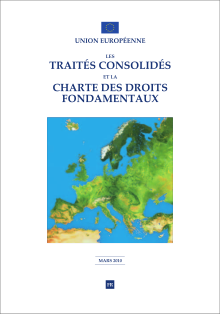
Back معاهدات الاتحاد الأوروبي Arabic Trataos constitutivos de la Xunión Europea AST Tractats de la Unió Europea Catalan Европин бертан берташ CE Primární evropské právo Czech Den Europæiske Unions traktatgrundlag Danish Tratados constitutivos de la Unión Europea Spanish Euroopan unionin perussopimukset Finnish Traités de l'Union européenne French EU-szerződések Hungarian
| Treaties of the European Union | |
|---|---|
 Front page of an EU document containing the consolidated treaties and documents which comprise the legal basis of the EU | |
| Location | Italian Ministry of Foreign Affairs |
| Purpose | Establishing the laws and principles under which the European Union is governed |
The Treaties of the European Union are a set of international treaties between the European Union (EU) member states which sets out the EU's constitutional basis. They establish the various EU institutions together with their remit, procedures and objectives. The EU can only act within the competences granted to it through these treaties and amendment to the treaties requires the agreement and ratification (according to their national procedures) of every single signatory.
Two core functional treaties, the Treaty on European Union (originally signed in Maastricht in 1992, The Maastricht Treaty) and the Treaty on the Functioning of the European Union (originally signed in Rome in 1957 as the Treaty establishing the European Economic Community i.e. The Treaty of Rome), lay out how the EU operates, and there are a number of satellite treaties which are interconnected with them. The treaties have been repeatedly amended by other treaties over the 65 years since they were first signed. The consolidated version of the two core treaties is regularly published by the European Commission.
Despite the withdrawal of the United Kingdom from the bloc in 2020, its name remains officially on some of the treaties (the SEA, Maastricht, Amsterdam, Nice and Lisbon and all accession treaties between 1972 and 2011) as it was part of the consultation and ratification process as a member state at the time those treaties were drawn up, though the country is no longer legally bound by them itself. This can only be altered by a future amendment to the treaties.